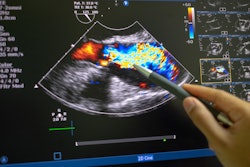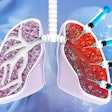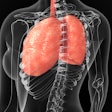
In people who have long COVID, lower pulmonary gas exchange may be connected to impaired cognitive function. This is according to a study that will be presented at the Radiological Society of North America (RSNA)’s annual meeting at the beginning of December.
A research team from the University of Iowa in Iowa City used magnetic resonance imaging (MRI) to analyze associations between pulmonary gas exchange and structure, function and cognition in the brain and lungs. In pulmonary gas exchange, oxygen moves from the lungs to the bloodstream and carbon dioxide moves from the bloodstream to the lungs.
“This is the first time that MRI has been used to jointly assess lung and brain function to investigate the relationship in long COVID. This research is new in that it combines multiple unique imaging types to study a multiorgan relationship in a disease population,” said lead author Keegan Staab in a press release. Staab is a graduate research assistant in the Department of Radiology at the University of Iowa.
Approximately 17.6% of U.S. adults have experienced long COVID, per the National Center for Health Statistics. Brain fog, or difficulty concentrating, is a common symptom, in addition to fatigue, joint or muscle pain, loss or change in sense of smell or taste, dyspnea, and more. Long COVID symptoms can persist for weeks, months or years after infection.
The study followed 10 female and two male patients (median age: 59 years) who had persistent dyspnea and/or fatigue after recovering from acute COVID-19. The participants completed cognitive and pulmonary function tests, structural and functional brain MRI and hyperpolarized Xe pulmonary MRI.
“129Xe MRI allows for advanced measurements of ventilation and gas exchange,” Staab said. “The literature also indicates that 129Xe may be more sensitive to pulmonary injury compared to standard breathing tests, making it better suited to study long COVID, in which patients typically have normal breathing tests.”
 Keegan StaabUniversity of Iowa
Keegan StaabUniversity of Iowa
“There was a range of cognitive difficulties among the patients in the study,” said Staab. “Some were mild and indicated slight dysfunction, while others were more serious and indicated that some patients have slow thinking and trouble concentrating several times per day.”
Results of the study indicated that lower pulmonary gas exchange may be associated with cognitive dysfunction and decreased gray and white matter volumes in patients with long COVID. The researchers also observed significant relationships suggesting that increased cerebral blood flow is linked to decreased gas exchange.
“This relationship could be a compensatory mechanism where lower lung function is compensated by higher cardiac output and higher brain perfusion,” Staab said. “It’s also a possibility that the disease mechanism that impairs gas exchange also leads to higher brain perfusion through downstream vascular injury in both lung and brain.”
Senior study author Sean B. Fain, PhD, professor and vice chair for research in the University of Iowa’s Department of Radiology, said these results may be able to help identify long COVID patients who need additional treatment or long-term management.
“If these findings can be generalized to the long COVID population, the study suggests that there may be a causative relationship between cognitive dysfunction and lung dysfunction, suggesting a potential treatment strategy using methods that target improved gas exchange,” Dr. Fain said.























